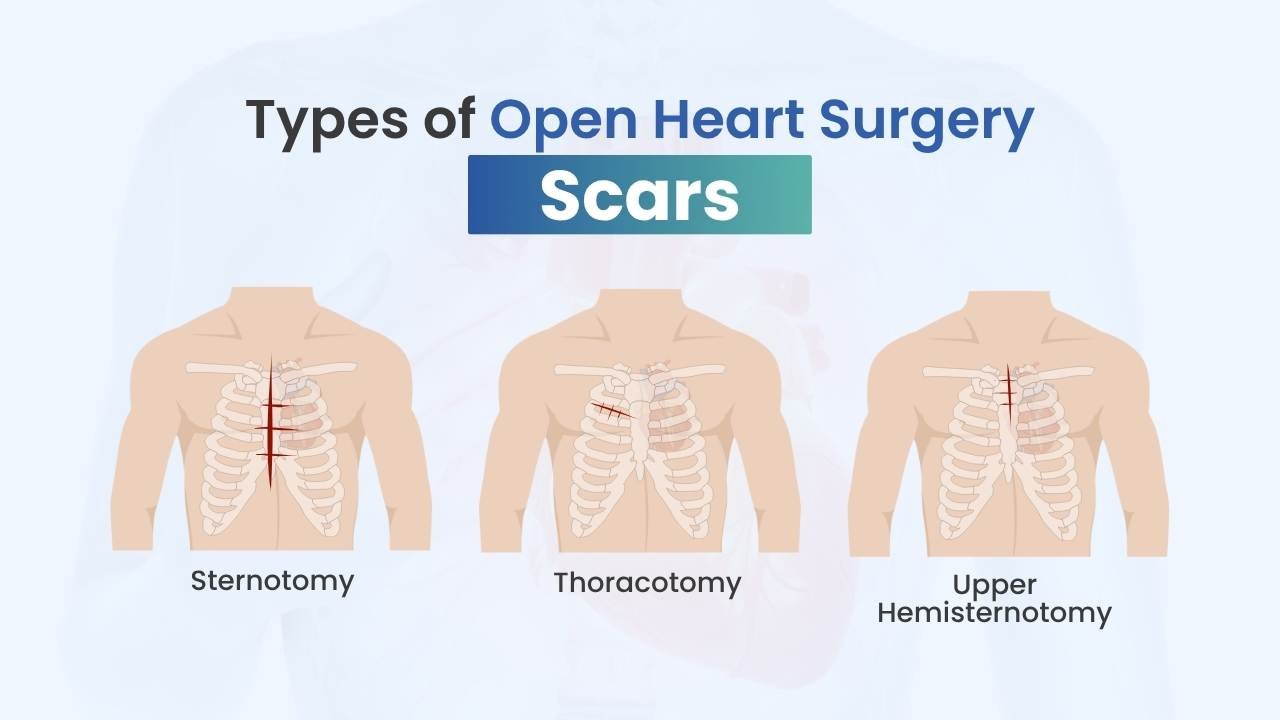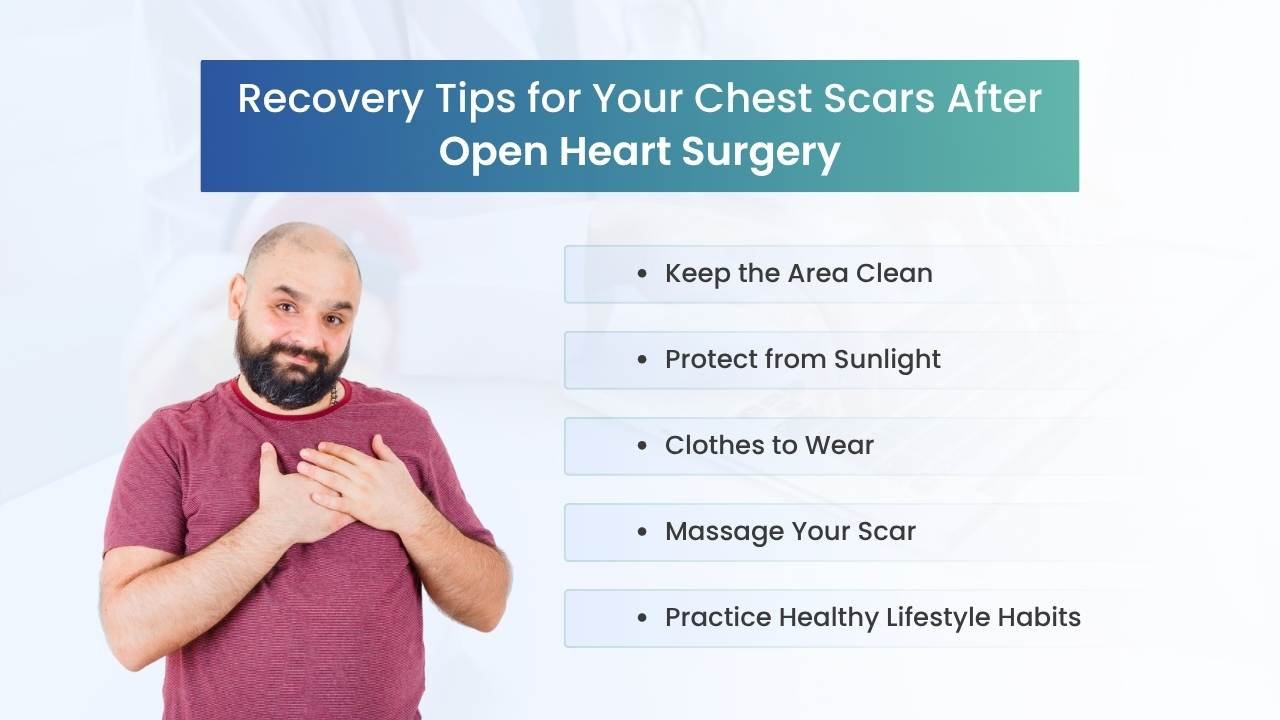Home Blogs Cardiac Surgery Open Heart Surgery Scar

An open heart surgery scar is a common result of procedures like CABG, sternotomy, or thoracotomy. However, scars usually appear reddish and raised in early weeks, then gradually fade and smooth within 6–12 months. Furthermore, proper care, keeping the area clean, protecting from sunlight, massaging gently, and following recovery tips, helps healing.
Open heart surgery is a complex procedure that involves opening the chest to reach the heart to treat the issues. However, knowing the open-heart surgery scar can help you to prepare for it and take the necessary steps for it. Read this article, and you will get all the details about the open-heart surgery scar, healing timeline, and tips as well.
Open heart surgery, also known as coronary artery bypass graft (CABG), is a procedure in which your chest is cut to perform the surgery on your heart’s muscle, valves, or arteries. However, it is the most common type of surgery done on adults, in which a healthy artery or vein is attached to a coronary artery to bypass a blocked area, allowing blood flow to the heart freely.
However, open-heart surgery is sometimes called traditional heart surgery, but nowadays many new heart surgeries are performed with small incisions, known as minimally invasive surgery.

The size, location, and appearance of your scar depend on the type of heart surgery that you have undergone and what incisions your surgeon has made.
Open heart surgery scars are typically caused by some problems, which include:
This is the classic vertical incision, which is created down the middle of your chest, helping to split your breastbone, and measures approximately 6 to 8 inches. However, valve repair or replacement, heart transplantation, and aortic aneurysm repair are the common procedures that use this incision.
This process is also known as a mini sternotomy, in which the scar from this type of heart surgery, caused by a smaller vertical incision in the middle of your breastbone that measures about 3 to 4 inches.
This is also known as open surgery, which helps in providing access to your thoracic cavity. However, a horizontal incision is made along your ribs on either the left or right side of your chest, which depends on what organ your surgeon wants to see or operate on.
Healing open-heart surgery scars can take time, and knowing about their timeline and other major factors can help you understand the process. Let’s talk about the timeline of open-heart surgery scars, the stage-by-stage process in detail:
These days, your scar will be more prominent, especially in the dark pink or reddish color, slightly raised, and sensitive. However, it may be itchy, feel tight, or even be mildly uncomfortable. However, tenderness and slight swelling are perfectly normal at the early stage, and here are some recommendations that you can follow:
At this stage, you will start to notice minor changes in which redness begins to fade, and swelling gradually subsides. However, your scar might feel itchy, and sometimes intensely as the nerve around it starts to regenerate, which could be frustrating, but it’s actually a sign your body is healing properly.
Here’s what you can do:
In this period of time, your scar continues to mature significantly, starts to flatten, soften, and lighten in color, which is gradually moving towards a less noticeable appearance. However, itchiness and sensitivity usually decrease substantially, though mild numbness or sensitivity on the scar can persist, and it is completely normal.
Here’s what you can do for that:
At this stage, your scar is mostly healed into its permanent appearance, which typically becomes paler, smoother, and far less noticeable compared to the initial weeks. However, most discomfort or abnormal sensations fade away by this time, but a slight sensitivity or numbness around the area can be irritating for some people.
Here’s what you can do for that:

Recovery from open-heart surgery requires special attention; however, understanding proper incision care is essential to prevent any complications. Here are some steps that will help in your healing process:
You must keep the chest region clean, which helps in preventing infection and also supports proper healing. Also, gently washing the area with mild soap and water helps the wound close while reducing the buildup of bacteria around scar tissue.
Exposure to direct sunlight can cause dark skin and make scars more noticeable over time. However, using protective clothing or applying sunscreen with high SPF can help shield the incision from harmful UV rays.
Loose, breathable clothing is the best option in the early stages of recovery because it reduces friction and irritation around the incision site. Additionally, soft fabric helps in protecting the area while maintaining comfort throughout the day.
Once your surgeon confirms it's safe, then you can gently massage your scar because it helps in improving circulation and helps in breaking down dense tissue around the incision. However, using light pressure with clean hands or a recommended lotion can help soften scar tissue and improve flexibility in the chest area.
A balanced lifestyle contributes greatly to how your body heals after a complex surgery. However, eating healthy, nutrient-rich food, staying hydrated, and following all the guidelines can strengthen your immune system and support recovery.
Open-heart surgery involves significant recovery, especially concerning chest scars. However, understanding the types of incisions, the healing timeline, and proper scar care is essential for a smooth recovery. With time, scars typically fade and become less noticeable. By following medical advice, practicing good hygiene, protecting the scar from sunlight, and maintaining healthy habits, you can support proper healing and also improve the appearance and comfort of your surgical scars.

Written By
I'm a content writer at Mejocare.com, where I create easy-to-understand and informative healthcare content. With 4+ years of experience, I help people learn about important health topics and connect with healthcare providers through clear and engaging writing.
I focus on making complex medical information simple and useful, ensuring that readers can easily find the answers they need.
What I do:
I’m committed to helping Mejocare share reliable health information with its readers.
SOURCE
HISTORY
At Mejocare, we prioritize accuracy and reliability. Our content is based on peer-reviewed studies, academic research, and medical associations. We avoid tertiary references. Learn more in our editorial policy. Trustworthy health information for you.
https://health.clevelandclinic.org/heart-surgery-scars para no 1,2 https://atlanticcardiovascular.com/blog/open-heart-surgery-scar/ para no 7,8,9,10,11,12 https://www.thekeloidplasticsurgerycenter.com/blog/open-heart-surgery-scar-healing/ para no 3 https://www.healthline.com/health/open-heart-surgery para no 1
CURRENT VERSION
Our care team can help you.
